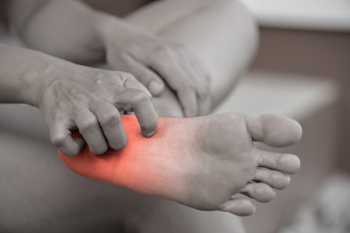 An ankle sprain can be the result of stretched or torn ligaments from suddenly twisting the ankle. As the ankle rolls outward, the foot turns inward, and this can cause the inside of the ankle to become damaged. The symptoms that many patients experience can include immediate bruising, swelling, and difficulty walking. After a proper diagnosis is made, which generally involves having an X-ray taken, treatment can begin. This typically begins by wrapping the affected ankle in an elastic bandage, as this is helpful in providing the necessary support to the ankle during the healing process. Additionally, it is beneficial to elevate the sprained ankle, which can alleviate some of the swelling. If you have sprained your ankle, it is strongly suggested that you consult with a podiatrist who can diagnose and treat this injury.
An ankle sprain can be the result of stretched or torn ligaments from suddenly twisting the ankle. As the ankle rolls outward, the foot turns inward, and this can cause the inside of the ankle to become damaged. The symptoms that many patients experience can include immediate bruising, swelling, and difficulty walking. After a proper diagnosis is made, which generally involves having an X-ray taken, treatment can begin. This typically begins by wrapping the affected ankle in an elastic bandage, as this is helpful in providing the necessary support to the ankle during the healing process. Additionally, it is beneficial to elevate the sprained ankle, which can alleviate some of the swelling. If you have sprained your ankle, it is strongly suggested that you consult with a podiatrist who can diagnose and treat this injury.
Although ankle sprains are common, they aren’t always minor injuries. If you need your ankle injury looked at, contact one of our podiatrists from Canonsburg Podiatry Associates. Our doctors can provide the care you need to keep you pain-free and on your feet.
How Does an Ankle Sprain Occur?
Ankle sprains are the result of a tear in the ligaments within the ankle. These injuries may happen when you make a rapid shifting movement while your foot is planted. A less common way to sprain your ankle is when your ankle rolls inward while your foot turns outward.
What Are the Symptoms?
- Pain at the sight of the tear
- Bruising/Swelling
- Ankle area is tender to touch
- In severe cases, may hear/feel something tear
- Skin discoloration
Preventing a Sprain
- Wearing appropriate shoes for the occasion
- Stretching before exercises and sports
- Knowing your limits
Treatment of a Sprain
In many cases, the RICE method (Rest, Ice, Compression, and Elevate) is used to treat ankle sprains. However, you should see a podiatrist to see which treatment option would work best with your injury. In severe cases, surgery may be required.
It is important to ask your doctor about rehab options after you receive treatment for your injury. Stretching, strength training, and balance exercises may help the ankle heal while also preventing further injury.
If you have any questions, please feel free to contact our office located in Canonsburg and McMurray, PA . We offer the newest diagnostic and treatment technologies for all your foot care needs.









